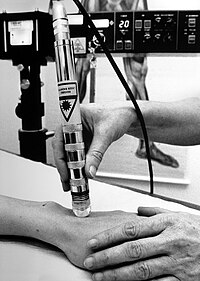
Photo from wikipedia
Abstract Non-healing wounds are among the main causes of morbidity and mortality. We recently described a novel, serum-free ex vivo expansion system, the quantity and quality culture system (QQc), which… Click to show full abstract
Abstract Non-healing wounds are among the main causes of morbidity and mortality. We recently described a novel, serum-free ex vivo expansion system, the quantity and quality culture system (QQc), which uses peripheral blood mononuclear cells (PBMNCs) for effective and noninvasive regeneration of tissue and vasculature in murine and porcine models. In this prospective clinical study, we investigated the safety and efficacy of QQ-cultured peripheral blood mononuclear cell (MNC-QQ) therapy for chronic non-healing ischemic extremity wounds. Peripheral blood was collected from 9 patients with 10 chronic (>1 month) non-healing wounds (8 males, 1 female; 64-74 years) corresponding to ischemic extremity ulcers. PBMNCs were isolated and cultured using QQc. Within a 20-cm area surrounding the ulcer, 2 × 107 cells were injected under local anesthesia. Wound healing was monitored photometrically every 2 weeks. The primary endpoint was safety, whereas the secondary endpoint was efficacy at 12-week post-injection. All patients remained ambulant, and no deaths, other serious adverse events, or major amputations were observed for 12 weeks after cell transplantation. Six of the 10 cases showed complete wound closure with an average wound closure rate of 73.2% ± 40.1% at 12 weeks. MNC-QQ therapy increased vascular perfusion, skin perfusion pressure, and decreased pain intensity in all patients. These results indicate the feasibility and safety of MNC-QQ therapy in patients with chronic non-healing ischemic extremity wounds. As the therapy involves transplanting highly vasculogenic cells obtained from a small blood sample, it may be an effective and highly vasculogenic strategy for limb salvage.
Journal Title: Stem Cells Translational Medicine
Year Published: 2022
Link to full text (if available)
Share on Social Media: Sign Up to like & get
recommendations!